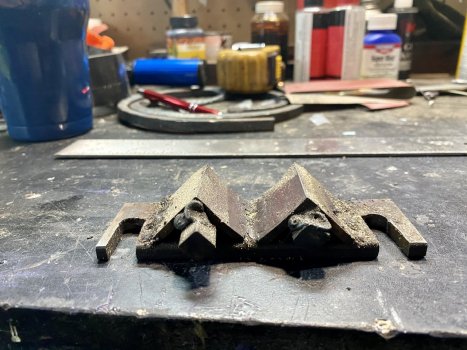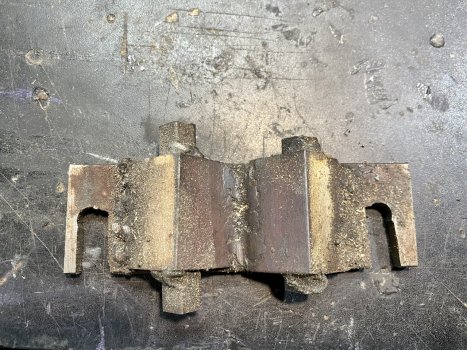Looking to bounce a couple ideas around here. It's rainy today so not at all sure I'll get to use the new 12 ton press outside today or not. The next few days should be nice.
First, for Canister Damascus - for a trial run I have plenty of 1.5" square tubing, but it's only 1/16" thick walls. I've got 1084 powder (real fine) and a bit of roller chain. Is there a chance that 1/16" wall will hold together enough for a solid weld with only flat dies?
Next, for a billet I've got strips of 1075 that are 1/8"X1.5"X7" and 15N20 that is .070"X1.5"X7". The idea is to grind all sides clean, clamp in vise and weld 3 spots on each side and one weld down the middle of each end. Weld a holding rod on the end. Since I can't use it today would soaking in kerosene be a good way to hold it until ready to forge in a day or so?
On forging the idea is to place in forge at 2200F, heat until a very dull glow, pull out and sprinkle borax heavy on each side and back into forge until the billet looks like it's glowing the same color as the forge, then leave a few minutes more to be sure it's hot?
Then to press using flat dies and press. Let's say the billet is 1.5" high, how much should I press first run to set the weld? 1/8" all the way length of billet. Heat again before pressing other side? OR - try to press both sides on a single heat?
How thick should I expect the 1.5" billet to be after setting the weld?
After the weld is set how long should the billet be after drawing for cutting and stacking? Would it be best to cut billet in half, weld, draw out again, cut in half again making a total of 4 stacks? OR - would it be best to draw billet out and cut in 1/3rd for a single 3 stack to weld next time?
I know this is all VERY basic, but remember this is my first time with a press. All very new to me and knowing I'm going to make mistakes, I'd like to stack the odds in my favor as much as possible

Thank ya'll for any help and guidance in this endeavor.
Ken H>
First, for Canister Damascus - for a trial run I have plenty of 1.5" square tubing, but it's only 1/16" thick walls. I've got 1084 powder (real fine) and a bit of roller chain. Is there a chance that 1/16" wall will hold together enough for a solid weld with only flat dies?
Next, for a billet I've got strips of 1075 that are 1/8"X1.5"X7" and 15N20 that is .070"X1.5"X7". The idea is to grind all sides clean, clamp in vise and weld 3 spots on each side and one weld down the middle of each end. Weld a holding rod on the end. Since I can't use it today would soaking in kerosene be a good way to hold it until ready to forge in a day or so?
On forging the idea is to place in forge at 2200F, heat until a very dull glow, pull out and sprinkle borax heavy on each side and back into forge until the billet looks like it's glowing the same color as the forge, then leave a few minutes more to be sure it's hot?
Then to press using flat dies and press. Let's say the billet is 1.5" high, how much should I press first run to set the weld? 1/8" all the way length of billet. Heat again before pressing other side? OR - try to press both sides on a single heat?
How thick should I expect the 1.5" billet to be after setting the weld?
After the weld is set how long should the billet be after drawing for cutting and stacking? Would it be best to cut billet in half, weld, draw out again, cut in half again making a total of 4 stacks? OR - would it be best to draw billet out and cut in 1/3rd for a single 3 stack to weld next time?
I know this is all VERY basic, but remember this is my first time with a press. All very new to me and knowing I'm going to make mistakes, I'd like to stack the odds in my favor as much as possible

Thank ya'll for any help and guidance in this endeavor.
Ken H>









